![]()
Aroids and other genera in the Collection
Take the Tour Now?
Orchids
The
Exotic Rainforest
The images on this
website are copyright protected. Please contact us before any reuse.
"Much of what we believe is
based on what we have yet to be taught. Listen to Mother Nature. Her advice
is best."
Aroid (Araceae) and
Tropical plant
Botanical
Terminology
with Latin pronunciations
Definitions you can understand,
many illustrated.
Written and compiled by Steve Lucas
with the assistance of
Dr. Thomas B. Croat PhD,
P.A. Schulze Curator of Botany
of the Missouri
Botanical Garden in St. Louis, MO,
D. Christopher Rogers, Elizabeth Campbell and
aroid botanist Peter Boyce in Malaysia
All photos Copyright Steve Lucas unless otherwise credited.
This article originally appeared in Aroideana, Volume 33, 2010, the
journal of the International Aroid Society,
Since that publication the work has been substantially edited and more
than 140 additional terms added as well as the Latin pronunciations
"Much
of what we believe is based on what we have yet to be taught. Listen to
Mother Nature. Her advice is best."
Steve Lucas, 2007
When I began to collect aroids in the 1990's scientific names were not important. I didn't tag anything and had no interest in those big words that were impossible to pronounce or understand. My only interest was the shapes of the leaves and the beauty of the flowers, especially those that produced an inflorescence (group of flowers). I suspect some of you may feel the same way now.
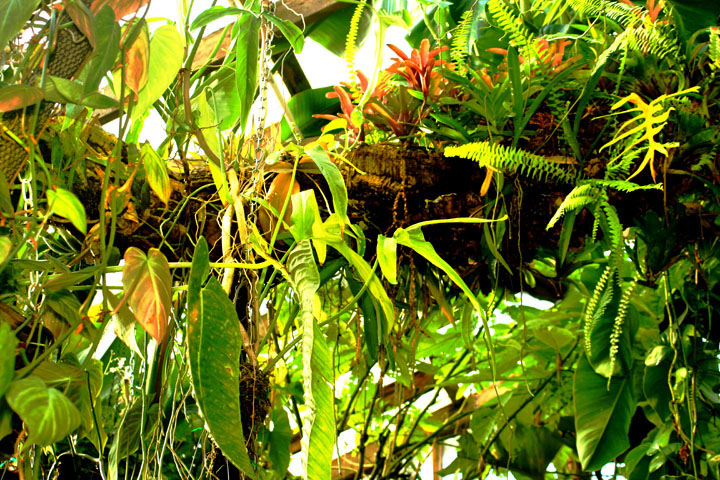 If you have read
many pages on this website you already know our primary interest is
plants in the family Araceae, the aroids but we grow many other species
including Gingers, Ferns, Orchids and other species and genera. My
first interest was the size of the leaves produced by many aroids,
especially Philodendron, Anthurium, Alocasia and Xanthosoma,
but like many aroiders my goals began to change as my collection grew.
If you have read
many pages on this website you already know our primary interest is
plants in the family Araceae, the aroids but we grow many other species
including Gingers, Ferns, Orchids and other species and genera. My
first interest was the size of the leaves produced by many aroids,
especially Philodendron, Anthurium, Alocasia and Xanthosoma,
but like many aroiders my goals began to change as my collection grew.
Soon I realized if I wanted my plants to reach their full potential and grow as large as I had hoped, I needed to know more about each specimen including how they were constructed, where they originated in nature, and what makes them remain healthy. I needed to know the conditions in which they grow naturally along with how all those strange plant parts perform. I realized that just knowing a plant by a common name or simply as an “elephant ear” or a Philodendron didn't provide any useful information. I needed to understand at least portions of some of their scientific background.
I am a serious plant collector so being able to understand the scientific treatment or description of a species is important. I need to know how to tell one species from another, a petiole from a stem and why a spathe is not a flower. Even though I am not a botanist I have received training courtesy of some of the world’s top botanists and have learned that self-education and knowledge are the "tools" that can drive misinformation and ignorance from any human mind.
At first, I only wanted to find the “simple stuff” which was often found on garden websites or in a consumer magazine. The problem with simple information that is not scientifically written or verified is that much of it is incorrect, especially information published on numerous garden websites. More often than not that information is composed of little more than casual observation or downright invalid ideas written by a house plant grower that knows little more than the average hobbyist has already discovered. It is extremely regrettable that this misinformation then becomes "accepted" and is repeated again and again throughout the internet.
Once you begin to try to understand scientific information you realize the scientists who write these texts and journals are speaking a “language” most of us don't understand. When a botanist writes it is impossible to explain each and every complex part of a plant using only words of two syllables. Just as your doctor or lawyer uses words, which have no meaning to the untrained, a scientist needs a set of words, which are a scientific form of shorthand. Those “shorthand” words easily transmit a complex thought to others with similar interest or training.
As a result words such as “anthesis”, “inflorescence”, “acroscopic” and “intravaginal squamule” had to be contrived, often using descriptive terminology from either Latin or Greek. The use of the classic languages came about since in previous centuries these were the main common languages that crossed national boundaries.
Ask yourself; do
you know the major differences in Anthurium and Philodendron
species? Did you know the definitions of some basic terms could help
you learn that one genus has both a geniculum and a collective vein
while the other has neither? Just read the definitions below and you'll
know how to tell those genera apart!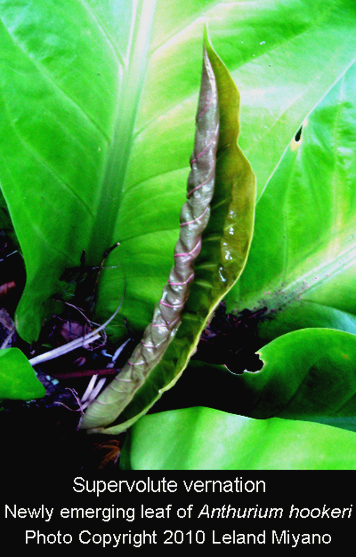
Here's an example why understanding scientific terms can be useful to any plant collector: Many collectors believe they are growing Anthurium hookeri in their yard or collection. Almost every aroid grower believes Anthurium hookeri is a common form of an Anthurium group known as the “birds nest” forms, which belong to Anthurium section Pachyneurium. If you read Dr. Thomas B. Croat's information in his Annals of the Missouri Botanical Garden Volume 78 #3, published in 1991 you'll find this information regarding whether or not the species is a part of section Pachyneurium, “Anthurium hookeri does not belong there. It differs from all species of section Pachyneurium by having supervolute vernation and leaf blades with scalariform secondary venation and glandular punctations on the lower blade surface.” Supervolute leaves unfold differently than those of all the species in section Pachyneurium since species in section Pachyneurium produce leaves with involute vernation. So what did Dr. Croat just say?
He just explained the new leaves of Anthurium hookeri open with an arrangement where one edge of the new leaf blade is rolled inward and the opposite is rolled around the midrib with the leaves appearing similar, if cut across, to the coiled whorl of a conch shell. Still sound confusing? It really isn't, but you do have to read the definition carefully a few times. He then goes on to say the interprimary lateral leaf veins are scalariforme which means they are evenly spaced like the rungs of a ladder. Understanding that both supervolute vernation as well as scalariform vein arrangements are not common in the birds nest Anthurium group would be very important to collectors who believe they are growing Anthurium hookeri.
So what is an interprimary lateral leaf vein? The definition can be found in this text. Once you complete reading the opening to this article go down and look up all these terms since they will become even clearer.
Dr. Croat then goes
on to describe another important clue to finding if the plant in your
collection is the real Anthurium hookeri when he states the leaf blade
possesses small black dots known as glandular
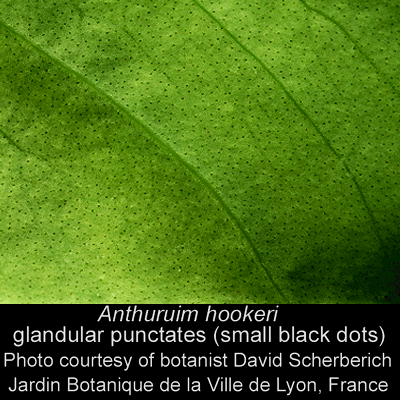 punctations. If you do
not find these when you carefully examine a specimen believed to be
“Anthurium hookeri” you have found that you are not growing the species:
in fact, the majority of plants sold in the United States with that name
are hybrids which are rarely related to the true species! These
specific points in the description can be important.
punctations. If you do
not find these when you carefully examine a specimen believed to be
“Anthurium hookeri” you have found that you are not growing the species:
in fact, the majority of plants sold in the United States with that name
are hybrids which are rarely related to the true species! These
specific points in the description can be important.
It isn't uncommon for sellers on some internet auction sites to offer unknown plants as desirable species, through ignorance or even with intent to deceive. A few years ago there were aroids being sold on the internet as Anthurium jenmanii, which were demanding a very high price. Many were caught up in the frenzy only to learn eventually they had bought a completely different species known correctly as Anthurium bonplandii subspecies guayanum.
One of the keys to recognizing the difference in the two species is that Anthurium bonplandii subsp. guayanum possesses those black dots known as glandular punctates (also found on Anthurium hookeri) while Anthurium jenmanii does not. By reading Dr. Croat's treatments any collector can determine the differences in the two species and may be able to tell if they are about to pay for a specimen that is not what they believe they are about to buy – or at worst, complain when the misnamed species is delivered.
Although scientific
terms are frequently based in Latin, this text is not written as a
tutorial to pronounce Latin-based terms even though many people are shy
about their pronunciation. Many Latin words can be spoken differently
depending on a variety of factors. Some words have also been
assimilated into the various languages so that a commonsense approach is
all that is needed.
According to information in W. Sidney Allen, Vox Latina there are
multiple sources indicating Latin alphabet was meant to be spoken
phonetically and Roman grammarians left surprisingly detailed
information about the sounds of their language. If you realize there are
at least four rival ways of speaking Latin ranging from classical to the
scientific use as well as Church Latin the pronunciation of Latin
becomes somewhat less confusing.
When I expressed my concern to my friend Elizabeth Campbell about trying
to explain Latin in as simple terms as possible as well as the fact
some seem to feel "Latin is a dead language" she responded
“If anybody tries
to tell you that Latin is a dead language I'd point out that it's very
much alive ‑ it's the official language of the Holy See, so the Church
is keeping it alive, as do taxonomists the world over and most scholars
of the Classics! Botanical Latin is very close to what is called Vulgate
or Vulgar (common) Latin by linguists ‑ the structures and declensions
of the verbs and pronouns are much simpler than in Church Latin.”
It is more important we
learn to understand and use these terms than to speak them correctly!
The goal is to learn to use and understand them,
Elizabeth has
prepared an excellent review of the various forms in which Latin is in
common use to this day. The pronunciation guide to the
classical form may be useful since many people feel that these pronunciation rules are
superseded by custom in which the names of genera and species, even
though they are in Latin form have been absorbed into the language of
the country and pronounced very much as they were in that language. Go
ahead and do your best, and if the person to whom you speak wishes to
correct you, accept the correction and use it (or not) the next time you
must say the word. You will find many
aroid descriptions and treatments on the International Aroid Society
website at www.Aroid.org
or on the pages of this website.
Just because a botanist doesn't pronounce a word the same way a
biologist, the clergy, a Latin teacher or other scientist does not mean
anyone is wrong! The differences simply reflect different periods of
history. Carl Linnaeus who developed the method of classifying plants
and animals as well as other scientific pioneers are not perfectly
uniform in the way Latin words are used and as a result they will be
spoken differently depending on a variety of factors including the part
of the world in which you live. Even in North America words have
different pronunciations of English from region to region so it should only be
expected that it is impossible to give a uniform method of speaking
Latin terms around the globe.
It is simply important you understand the guides offered are only to
make the use of these terms simpler when exchanging information with
another plant enthusiast and not an attempt to teach Latin. Since
repetition is a major key to learning the more you say the words as you
speak, even incorrectly, the more they will become a natural part of
your understanding of the specimens in your collection.
Help using Latin by
Elizabeth Campbell
Rather than telling you how to pronounce these terms here are a set of
basic rules for Latin pronunciation. Phonetically pronounced terms are
from the Greek.
Basic Latin pronunciation is as follows: the stress in words of two syllables is given to the first, and in any word longer than two syllables it is normally given to the second syllable, except where indicated by a diacritic mark (usually an acute accent). There is often minor stress placed on the fourth syllable of words longer than four syllables. Pronunciation is phonetic, and runs in accordance with the following key.
VOWELS follow these rules:
A is always pronounced as the a in father
E is always pronounced as the a in bake; when it appears at the end of a word, it is always pronounced, and never silent. This generally has the effect of adding an extra syllable to the word.
I is always pronounced as the e's in bees
O is always pronounced as the o in folk
U is always pronounced as the o's in ooh
Y when found as a vowel, is always pronounced as the I in giant
The diphthongs AI and AU deserve special mention; they are pronounced as EYE and OW, respectively. Doubled vowels, as in the II common at the end of Latin botanical species names, are pronounced as two separate vowels with more stress on the first vowel than the second.
CONSONANTS are generally pronounced as in modern English, with the following exceptions.
C is always hard – it has the same sound as the English K.
G is always pronounced as the g in great.
H does not exist as a vocalized letter in the Latin alphabet; accordingly it is silent.
J does not technically exist in the Latin alphabet; where found it's pronounced as the vowel I.
V is pronounced as W, and there is no W in the Latin alphabet.
X is pronounced as Z when it appears at the beginning of a word, and as KS when it appears anywhere else.
The combination of PH is borrowed from Greek, and pronounced as F.
The combination of TH is pronounced as a hard and slightly accented T with the H silent. Hence, Anthurium is pronounced an-TOO-ree-oom. Modern pronunciation, however, uses the Germanic pronunciation of TH as in thorn. Both are correct, with the hard T being more classical.
The combination of QU is pronounced as K.
Doubled letters, like CC and LL, are pronounced twice, just like doubled vowels, with less stress on the second consonant.
However, caveat lector (reader beware): In common everyday use of botanical terms, it may be more convenient to ignore the Latin pronunciations of G, J, and V as it seems very awkward to Western tongues. Personally, in normal speaking I pronounce the vowels as according to the above key, dropping the final syllable caused by a terminal E, and give all letters other than TH and X their normal Western pronunciations.
For more help with Latin, visit: Latin Pronunciation Demystified
Commonly used Botanical terms
A
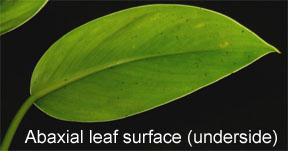 abaxial
(ab-AX-ee-al)
abaxial
(ab-AX-ee-al)
The underside or lower surface of a leaf, petiole or other plant surface See also adaxial
acroscopic
(a-crow-SCOPE-ic)
Meaning to proceed towards the apex (end or tip). Used to describe flowers and pollen that form from the base of a spadix toward the tip. See also basioscopic
acuminate
(ac-CUE-min-ate)
Tapering to a sharp point and becoming increasingly more acute
aculeate
(a-CUE-lee-ate)
Prickly pointed or possessing sharp prickles
acute
(a-CUTE)
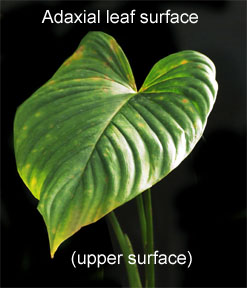 Gradually tapering to a point with a distinct but not acuminate point.
Used for a leaf or any part of a plant. See also acuminate
Gradually tapering to a point with a distinct but not acuminate point.
Used for a leaf or any part of a plant. See also acuminate
adaxial
(AD-ax-ee-al)
Facing the stem (the axis). The upper surface of a leaf, petiole or
other plant surface. See also abaxial
adventitious roots
(ad-ven-TISH-us)
Growing from a different organ. Adventitious roots are common to many aroids where they form from shoot tissues or grow from an unusual position
anatomy (a-NAT-omy)
As opposed to morphology, the study of the relationships of the internal parts of an organism including the arrangement of tissue qnd structural components and cells. Morphology generally is the study of the external parts of a plant or organism but the two terms are sometimes used synonymously See Morphology
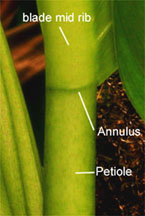
annulus
(AN-new-lus)
In aroids, a colored ring or circle often formed at the apex (end or
tip) of a
petiole at the point where the petiole and leaf blade join. Can be
used to determine some species since an annulus is not present in all
species and genera. The term can have additional definitions in
other plant forms
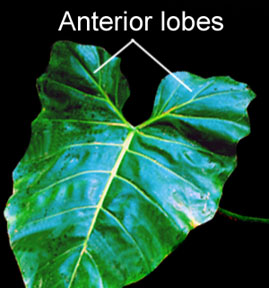 anterior
lobe (an-TEE-ree-or lobe)
anterior
lobe (an-TEE-ree-or lobe)
The portion of the leaf blade above the point of attachment of the petiole known as the petiolar insertion. Also known as terminal lobe(s) See also Lobes and Posterior lobes
apex (A-pex)
The point or tip of a leaf blade, cataphyll, root, spadix or other part of a plant
apical meristem (see Meristem)
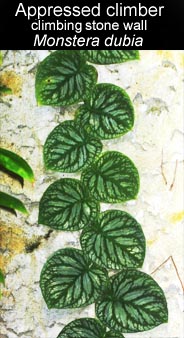 appressed
(a-PRESSED)
appressed
(a-PRESSED)
From the Latin appressus, the past participle of appremere meaning to
press closely to another object. In aroids refers to plant parts such as
the stem which grow pressed closely against the surface of a host (tree,
stone, etc.) for much of its length. Juvenile plants such as
Monstera dubia are well known as being so tightly appressed they often
appear to be "painted" on a wall or tree
Araceae
(a-RAY-see-eh, some use
a-RA-kay-eye)
A family of approximately 3800 species in 116-120 genera commonly known as aroids. An aroid is a plant that reproduces with an inflorescence including a spadix surrounded by a modified leaf known as a spathe. The spadix is a central fleshy spike on which both sexes of imperfect flowers with a single sex (male or female) as well as perfect flowers containing both sexes are formed. The only exception is the genus Lemna and its relatives known as “duckweeds”
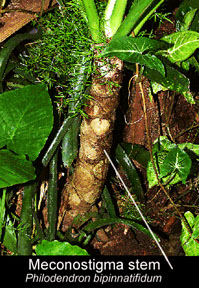
arborescent
(ar-bor-ES-ent)
Growth that is tree-like as well as sometimes called self heading when used to describe the stem of Philodendron subgenus Meconostigma species.
areole or areolate (areo-LATE)
Surrounded by veins.
areolar glands (areo-LAR glands)
In botany, the extra-floral nectaries located in Cactus and other genera in the tubercle groves or in the axils. These glands exude a thick juice known as a nectar that has a high sugar content. It is assumed by most researchers the nectar is a highly developed strategy for the attraction of ants. See also Extra-floral nectaries
aroid (AIR-oid)
Common name for plants in the family Araceae
articulated
A joint between two plant parts such as a leaf and a stem or the internodes of the stem.
asexual
The formation of new individuals from the parent plant without the involvement of sexual reproduction. Includes such reproductive processes as offsets produced adjacent to the parent
asperous (AS-per-us)
Minutely roughened, slightly rough to the touch
atypical (ah-TYPE-ee-cal, but more commonly spoken as a-TIP-ee-cal)
Does not conform to the type or
the norm. Irregular, unusual, not normal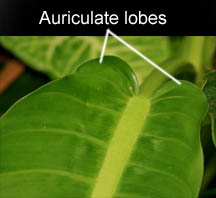
auriculate (or-IC-you-late)
Having “ears” or earlobe-shaped lobe extensions at the base of the blade. See lobe
autotroph (AUTO-trough)
Autotrophs create their own food
by utilizing photosynthesis. The process is completed through the
reduction of carbon dioxide by adding hydrogen in water (H2O) to create organic
compounds. The process is also known as CO2 Fixation or the PCR
Cycle (Photosynthetic Carbon Reduction). In green plants an autotroph converts physical energy from
sun light into carbohydrates in the form of sugars
In biology the term reduction
indicates the hydrogen is molecularly stripped away from the oxygen. They may also form
chemical energy by synthesizing complex organic compounds from simple
inorganic materials in order to produce fats and proteins from light.
The process is also known as being autotrophic See
also Photosynthesis
auxins (OX-ins) or (OWKS-ins)
the former is American, the latter British
Hormones formed in the growing points of stems and roots, which promote or inhibit cellular growth in plants. Low concentrations normally produce growth while higher concentrations inhibit growth.
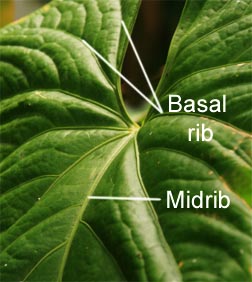
B
basal rib or basal vein (BAY-sal RIB)
Usually called the posterior rib and it is simply the fusion of 1 or
more of the basal veins
basionym
(BA-see-o-nim)
The
first valid name applied to a taxon, which may or may not have been
accepted by later workers as a result of their research. from the Greek
bainein, (step) and Latin nomen or nym (name).
Basionym indicates a basic step or first step in the naming process
basioscopic
(ba-see-o-SCOP-ic)
or (ba-see-o-SCOPE-ic)
Forming towards the base. Used to describe flowers and pollen that form from the apex (tip) of a spadix toward the base. See also acroscopic
bicarinate (bee-CAR-ee-nate)
To possess two
keel-like projections
bicolorous
(bi-COLOR-os)
Possessing two colors and applied to a single structure, usually a leaf
blade
binomial (bi-NOM-ee-al)
The two-name system in which the more explicit second part “species epithet” names a member of the broader category “genus” From the Latin nomen or nym (name)
bipinnate (bi-PIN-ate)
A doubly compound leaf blade in which the primary divisions are pinnae (feather-like) possessing secondary feather-like structures
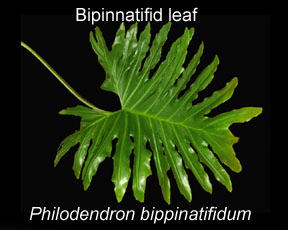
bipinnatifid bi-pin-AT-if-id)
A leaf similar to one which is bipinnate but with the divisions not forming distinct leaflets but rather areas separated by deep incursions from the margin (edge)
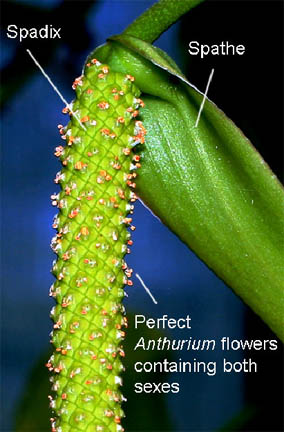 bisexual flowers
bisexual flowers
Bisexual flowers have the stamens (male organs) surrounding a single ovary (female organ)
bisexual inflorescence (bi-SEX-you-all in-flor-ES-sense)
An inflorescence possessing perfect flowers or protogynous flowers containing both male and female parts together throughout the length of the spadix. In aroid species the female flowers of a perfect flower are receptive prior to the production of pollen to preclude self-pollination. Bisexual species include Anthurium, Monstera, Dracontium, Stenospermation, Heteropsis, Rhodospatha, Spathiphyllum and others. See also unisexual inflorescence, florets and protogynous
blade
The flattened part of a leaf also referred to as a lamina.
bract
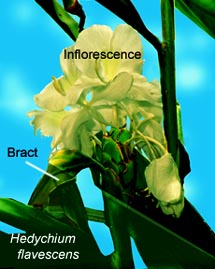 A modified leaf with a
flower or inflorescence at the axis (tip). Often but not always
different in form, color, size and texture from foliage leaves.
Usually associated with much smaller modified leaves. The term is used
for structures that serve many purposes including a reduced leaf below a
flower or inflorescence
A modified leaf with a
flower or inflorescence at the axis (tip). Often but not always
different in form, color, size and texture from foliage leaves.
Usually associated with much smaller modified leaves. The term is used
for structures that serve many purposes including a reduced leaf below a
flower or inflorescence
See Inflorescence
bud
An immature shoot protected by tough scale-like leaves from which the stem and petioles bearing leaves or a peduncle bearing an inflorescence can develop
bulb
An underground storage structure that is a condensed stem usually with a basal plate and fleshy storage leaves surrounding the bud that will form the next plant. A bulb is a storage structure used to store starches and water and is the central support of the plant. A bulb normally has a basal plate and true bulbs have the roots growing from the bottom. Bulbs also have layers of fleshy storage leaves surrounding the bud that will form the next plant. The modified leaves are arranged in layers that are used for food storage. The perfect example of a bulb is an onion, just slice one open and you can easily see the modified leaf layers. The term bulb is used mostly in horticulture but never applies scientifically to an aroid including Colocasia or Amorphophallus species. See stem
bullate (BULL-ate) or (BULE-ate)
A
surface with a blister-like appearance or having blister-like swellings.
C
caducous
Describing parts that soon drop off or fall off easily or at an early stage
calcium oxalate crystals
The salt of oxalic acid in the form of white crystals that are insoluble in water. Oxalate crystals are common in the leaves and other parts of Araceae but are also found in many edible plants including spinach. Often described on the internet as a "poison", if ingested in excessive amounts the crystals are collected in the blood and body where they can be stored in the kidneys and bladder causing difficulty in urine discharge through the urethra (kidney stones). Although the raphids found associated with oxalate crystals can cause mild to extreme pain and discomfort to the mouth and throat, large quantities would be required to be fatal in almost all cases. Some aroids including Colocasia esculenta which contain oxalate crystals are commonly cooked and eaten around the world since heat and cooking may assist in the break-down of some of the crystals
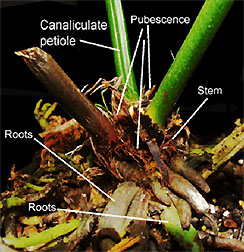
canaliculate (can-al-IC-you-late)
A
channeled or furrowed groove seen in the surface of a plant part such as
the petiole or midrib of a leaf blade. See also sulcate and sulcus
carpel (CAR-pell)
The part of the female reproductive organs of a flower composed of a
chamber then ovary with one or more ovules. After successful pollination
this becomes part of the fruit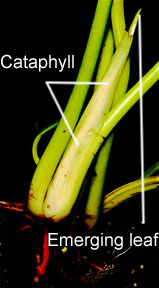
cataphyll (commonly (KA-ta-fill or KA-ta-feel)
A
bract-like modified leaf, which surrounds any newly developing leaf to
protect an emerging blade as it develops. A cataphyll may be unribbed as
well as single or double ribbed and in some genera have important
characteristics used to determine the species
caudex
(commonly (CAW-dex or COW-dex)
The thickened base of a stem from which new leaves and reproductive parts may arise. It may be an underground or at ground level and the principal purpose is not water storage but is instead a stem that has roots at all the internodes in contrast to most plants which have the stem and roots completely separated
chimera (KEE- mer-a)
A chimera is a plant or part of a plant such as a leaf blade that is composed of layers that are genetically different and whose apical meristem is composed of two different types of tissues, one pigmented and one not pigmented. The most common form is a variegated plant where the leaf may be partially white or yellowish as a result of a lack of the ability to synthesize chlorophyll. These white and yellow patterns are caused by tissues without chlorophyll or other plant pigments. This is normally due to defective tissue formed without pigments since the meristem that produced them lacks cells containing pigments. This kind of chimaral variegation is not stable and morphs as the plant grows. Many popular foliage plants including some commonly available aroids are chimeras and many are artificially created in tissue culture laboratories rather than by nature via the introduction of a harmless virus known as the Colour Break Virus which inhibits the growth of chlorophyll in parts of the plant including the leaf, stem and petiole. The Colour Break virus is often unstable and in many cases the variegation fades in time. Chimeras are also commonly seen in nature but neither chimeral variegation nor viral variegation is commonly passed along through seeds See also Photosynthesis
chloroplast (KLAWR-uh-plast)
Chloroplasts are chlorophyll enriched plastids surrounded by a double membrane that cause plants to appear green. They are the organelles (plastids) found in plant cells that produce photosynthesis. An organelle is a specialized sub-unit within a cell that has a specific function and in this case is the site where photosynthesis occurs. Chloroplasts are found in the majority of the cells of autotrophic plants that are exposed to light. Autotrophic indicates an organism that does not require other living organisms for food since they are capable of generating their own food from a living source including sunlight, water and gases including CO2 through a process known as CO2 Fixation. Photosynthesis then occurs when water molecules are split through a reaction with CO2. The chlorophyll found in the leaves then releases the oxygen to the environment as a bi-product resulting in the production of carbohydrates in the form of sugars that provide nourishment (thus growth) in the plant. Plants do not "make" oxygen, they release it as a result of the process of CO2 Fixation. See Autotroph and Photosynthesis
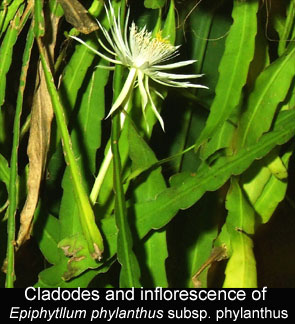
cladode (same as phylloclade)
A specialized stem that functions much like a leaf. The flattened photosynthetic organ of some plants in the cactus family (Cactaceae) including those in the genus Epiphyllum. A cladode is not a leaf even though in some species they often resemble and serve some of the purposes of a leaf. Instead a cladode serves as a swollen water storage stem segment
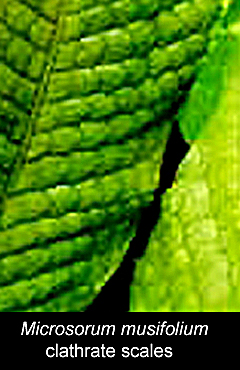 clathrate scale
clathrate scale
Often used in relationship with some fern species. To have a
lattice-like structure containing holes or windows. Used to designate a
compound in which one component is enclosed within the crystal-like
structure of another. A clathrate scale is capable of transmitting
light sometimes making it appear to have a range of colors making it
somewhat like a frond possessing the effect of having "stain glass
windows"
clone
A genetically identical descendant of a single plant
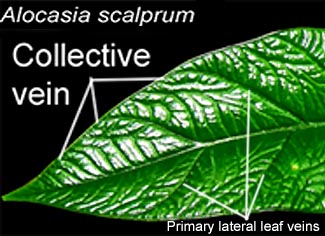
collective vein
Collective veins come in pairs and are simply the union of part of all of the primary lateral veins and extend all the way to the apex (end or tip). A submarginal vein (not touching the edge) that lies parallel as well as near the leaf margin into which the primary lateral veins run. The collective vein may be a continuation of a primary lateral leaf vein often the lowermost or the uppermost basil vein and are observed in Anthurium, Syngonium, Alocasia, Colocasia, Xanthosoma, Pycnospatha, Arisaema, Protarum, some Amorphophallus and other genera
compound leaf
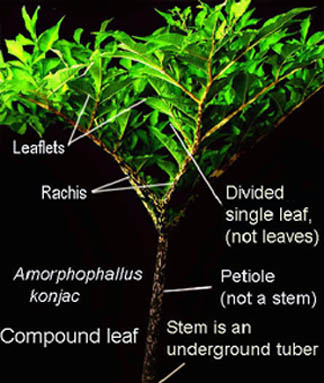 A single leaf composed of
two or more blades on a common stalk, in aroids often known as a rachis.
Depending on family and species, all the leaflets are attached to a
single support known as a rachis, midrib or axis. sometimes by a
petiolule that is a small stalk similar in function to a petiole.
Some aroids have neither a petiolule or a rachis. All the leaf
segments are more or less similar and are often oriented in the same
plane. The entire compound leaf is attached to the stem at a node by a
petiole. See Node, Petiole, Rachis, and Stem
A single leaf composed of
two or more blades on a common stalk, in aroids often known as a rachis.
Depending on family and species, all the leaflets are attached to a
single support known as a rachis, midrib or axis. sometimes by a
petiolule that is a small stalk similar in function to a petiole.
Some aroids have neither a petiolule or a rachis. All the leaf
segments are more or less similar and are often oriented in the same
plane. The entire compound leaf is attached to the stem at a node by a
petiole. See Node, Petiole, Rachis, and Stem
concolorous (con-COL-or-us)
Uniformly colored, as in the upper or lower surface of a leaf blade possessing a single color
convex (CON-vex)
Curved or bowed outwards
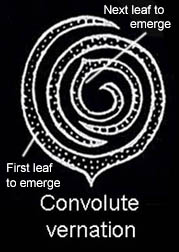
convolute vernation (con-vol-UTE
vern-A-shun)
Used to describe a newly unfurling leaf blade which has one half wholly rolled up in the other presenting itself as a tube. Convolute vernation occurs when several leaves spiral with the next leaf in a module enclosed within the current leaf. Synonymous with supervolute vernation but there is a slight difference since convolute involves a succession of leaves being formed as can be seen in the drawing to the right. See also Supervolute vernation and Involute vernation
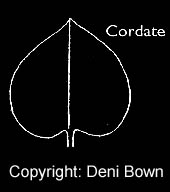 cordate
(CORD-ate)
cordate
(CORD-ate)
Heart-shaped, as in a heart-shaped leaf blade
coriaceous (cor-ee-A-shus)
Used to describe a leaf blade that feels leather-like or resembles the
texture of leather while remaining flexible.
See also subcoriaceous
corm
A somewhat controversial term not often used in aroid botany. Best described as an underground storage organ formed from a swollen stem base to which the above ground parts of the plant die back in the dormant season . A corm may function as vegetative reproduction organ which bears adventitious roots and scale leaves. Normally renewed annually with each new corm forming on top of the proceeding corm. A corm often stores starch and when the corm re-grows foliage the new growth will come from the top with the roots growing from its base. The roots of a corm always grow from the bottom, never from the top. Bananas grow from corms as do Gladiolas but the term corm is not scientifically appropriate for an aroid according to more than a few top aroid botanists. There are a select number of aroid species that have a corm-like tuber but the majority of scientists agree the term does not apply in the family Araceae (aroids). Although technically different from a tuber some authors still use corm and tuber interchangeably
A collective term for all the non-reproductive structures of a flower including the petals when considered as a group or unit. The inner whorl of the perianth. See also Perianth
cortex
The outer layer of a plant organ, especially a stem or root
cotyledons (cot-LAY-dons)
An embryonic seed leaf, which, after germination, either remains in the seed or emerges to, becomes green. Commonly monocots produce a single leaf while dicots commonly produce two, however there are exceptions. See monocot and dicot
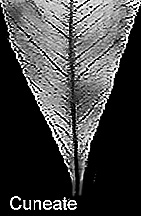
cuneate (CUE-ne-ate)
Describing a leaf that is Inversely triangular (upside down) with the wedge tapering towards the base of the leaf lamina. A cuneate leaf is attached at the narrowest point of the leaf. See also lamina
cuspidate
(CUS-pid-ate)
Sharply pointed, such as in the apex or point of a leaf.
D
deciduous (de-SID-you-us)
The shedding of leaves in a perennial plant. In aroids usually in the dry season to bring about a reduction of water loss through transpiration when little or no water is available to a specimen's roots. In botany, deciduous plants including trees and herbaceous perennials including those that lose all of their leaves for part of the year. Deciduousness denotes the plant is entering a period of survival as a reuslt of winter or a period of tropical dryness. During this period growth is generally significantly reduced or near dormant as is the production of reproductive organs. Once photosynthesis is interrupted due to a lack of available moisture the plant goes into a survival mode commonly known as dormancy and sheds all the leaves until adequate rainfall, warmth and sunlight return. The purpose is largely to the preservation of the plant's life as a result of an inadequate source of food, moisture or extreme cold. Stored carbohydrates within the plant that were created while photosynthesis within the leaves was active to provide the nourishment for survival and must then be preserved. See transpiration and photosynthesis
dicots or dicotyledons (DIE-cot) / (di-COT-ley-dons)
Flowering plants that typically have two embryonic leaves although sometimes more
dimorphic roots (di-MORF-ic roots)
A root system with two distinct forms adapted to perform different functions such as anchor root and feeder roots. Many aroids possess dimorphic roots
divaricate (dee-VAR-ee-cate)
A distinctive form of wide angle branching. Extremely divergent or spreading widely
E
ellipsoid
(el-LIPS-oid)
Generally egg-shaped but the strict mathematical definition is more complicated. See also globose.
elliptic (el-LIP-tic)
Having a shape that is rounded at each end more or less equally. Compare with ovate
endemic
(en-DEM-ic)
A plant species whose natural distribution is limited to a particular area or locality
epidermal
the outer-most cellular layer of the primary plant body
epigeal
(commonly epi-JEE-al or epi-GAY-el)
Occurring or growing above ground. Commonly referring to a form of seed germination with the emergence of cotyledons above the surface of the ground after germination. See cotyledons
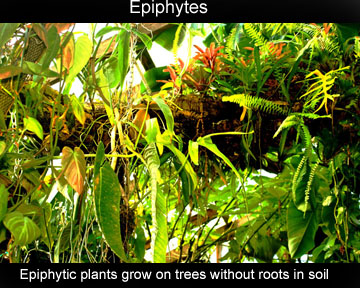
epiphyte (EPI-fite)
A plant that does not have roots in the soil living above the ground's surface supported by another plant, normally a tree. Epiphytes gather nutrients and water from the air or from organic debris left by the host or rain forest animals including birds, reptiles and animals. See also hemiepiphyte
epilithic (epi-LITH-ic)
Plants that grows on or attached to the surface of a rock or stone
epipelic (epi-PEL-ic)
A condition meaning to grow in mud
epipetric (epi-PET-ric)
Capable of growing on or creeping over rocks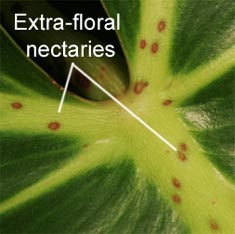
extra-floral nectary
A nectary born outside a flower, in aroids sometimes on the peduncle, stems, leaves as splotches with the color of a purple/reddish wine stain. Although nectaries secrete sweet liquids to attract pollinators an extra-floral nectary does not produce its liquid for the purpose of pollination but are often associated with ants and other animals that may provide an antiherbivore service. Extrafloral nectaries may also be found on the reproductive parts of a plant See also nectary, vinaceous and rachis
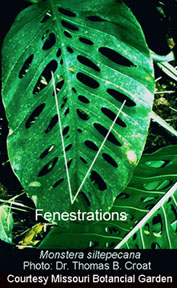 F
F
fenestration (fen-es-TRAY-shun)
Holes in the leaves or membranes. Commonly associated with the leaves of the genus Monstera. From the Latin fenestratus past participle of fenestrate meaning to possess openings or windows
fertilization (in the sense of leading to seed production)
The union of sperm and egg to form seed. After pollen grains formed by the male flowers of an aroid containing the male gametes (sexual cell) or sperm are transferred by an insect, small bird or other pollinator to the stigma of a female flower, they grow into the interior of the carpel and to the ovule (the female gamete). See also carpel, anthesis, stigma and ovule
flagella
plural of flagellum. (flag-EL-a) / (flag-EL-um) or (fla-GEL-um)
Moveable filementacious thread-like or tail-like structures that
projects up to 150 mm in length. Differentiated from cilia, which are
shorter, being 5-10 mm in length
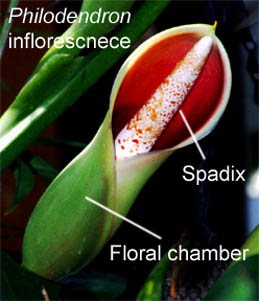
floral chamber
A specialized chamber at the base of a spathe associated with the inflorescences of Araceae including Philodendron, Alocasia and other genera. The floral chamber effectively hides the female and sterile male flowers and may channel the access of pollinators. Until pollination is complete the chamber may close at its apex (end or tip) preventing or slowing the escape of a pollinating insect. The spathe of Alocasia species is divided into a convolute (twisted) thicker lower portion which once the upper spathe dies encloses a fruiting region of the spadix which will eventually produce fruit (berries). The two zones of the spathe can be recognized by a narrowed constriction making the lower part containing the floral chamber appears globose or rounded to ovoid. See also spathe, spadix, and globose
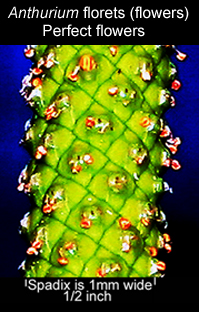 floret
floret
One of the individual small flowers of a cluster of flowers in an inflorescence
flower
The reproductive portion of a plant destined to produce seed. In Araceae
a flower contains either male or female organs or both. A flower with
both sex organs is said to be perfect while a flower with only one sex
is imperfect
forelobe (see anterior lobe)
frond
The often large divided or
compound leaf of a fern or palm or cycad See also Compound leaf,
Sori and Shield frond
G
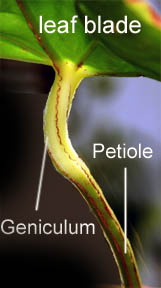
geniculum
(gen-IC-you-lum, sometimes jen-IC-you-lum)
A wrist-like organ located at the apex (end or tip) of the petiole. The geniculum allows a leaf to rotate and orient itself in order to control to a degree the sunlight which it receives. Unique to Anthurium, Spathiphyllum and a select number of aroid genera the term is also used similarly in a few other families
genus plural genera (JEE-nus)
(JEE-ner-ah)
A group of plants defined by common characteristics and divided into subordinate species. Always designated by a Latin or Latinized capitalized singular noun
glabrous (GLAB-rus)
A plant surface such as a leaf that is smooth and devoid of projections including pubescence. See pubescence
glandular punctates (GLAN-du-lar PUNK-tates)
Sometimes observed on the leaf blades of aroids, which are marked by small spots, pores or point-like depressions. Usually restricted to section Porphyrochitonium, Tetraspermium and Digittinervium but something like glandular punctations are present on sect. Calomystrium and sect. Urospadix (and Anthurium hookeri). The punctations on Anthurium bonplandii are not glands but rather unusual pustules. See photo, top of page
globose (GLOW-bose)
A ball-shaped part or organ of a plant, such as pollen granules, fruits or seeds
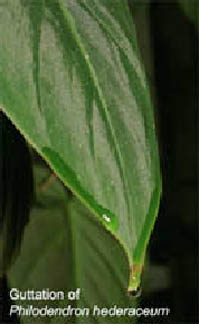
guttation
(gut-A-shun)
Derived from the Latin gutta (gut-TA) meaning droplet. Aroids and other plant species possess glands known as hydathodes capable of producing clear liquids during periods of low temperatures and still air motion. It is distinct from transpiration in which moisture in the blade passes through pores of the leaf blade and evaporates, an essential part of moving water from roots to leaves. See also Transpiration
gynoecium (guy-no-EE-see-um)
The collective term for the female reproductive portions of a flower.
H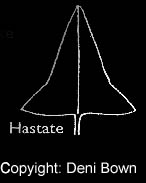
hastate (HASS-tate)
A leaf blade possessing the shape of an arrowhead or spear with the basal lobes pointing outward at right angles
hemiepiphyte
(HEMI-epi-fite)
Plants rooted in the soil but relying on the tree for support and growth. Primary hemiepiphytes begin as seeds in the droppings of a rain forest inhabitant which germinate on the trunk or limbs of a tree as do an epiphyte, then develop long roots which eventually reach the ground. In this way they attain height in the forest as quickly as possible in order to reach brighter light. The second type known as secondary hemiepiphytes start their lives in the soil or on a tree trunk near the ground and then send roots to the ground to gather additional nutrients. They then climb the host where they morph into the adult form and sometimes completely lose their connection to the ground at which point they then become epiphytes See Epiphytes
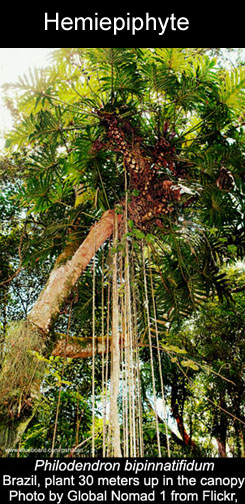
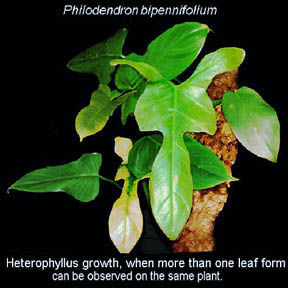
heterophylly or heterophyllus (het-er-O-file-ee and het-er-o-FILL-us)
Possessing differently shaped leaves on the same specimen
hippocrepicus
or hippocrepiform
(hip-o-CREP-ic-us
or hip-o-CREP-if-orm), technically but rarely used (eep-o-CRAPE-eek-oos
or eep-o-CRAPE-ee-form)
Bent almost into the shape of a circle while still possessing a distinct opening somewhat like the shape of a horse shoe
homeosis
In botany homeosis is the transformation of one body part into another generally as a result of mutation. In plants it is defined as the complete or partial replacement of one organ by a different organ and is believed to play a significant role in the ontogeny and phylogeny of reproductive organs. Homeosis has been studied In Araceae in the inflorescences of Philodendron and other genera and the concept is used largely in molecular biology. See Ontogeny and Phylogeny
homology (ho-MAH-lo-gee)
The likeness or similarity of different organisms that may carry out different functions such as human arm and the wing of a bird or the structural similarities between parts of differing plants. Often described as a result of evolutionary differentiation. Normally applied to corresponding parts with a common ancestral similarity that may be attributed to a common origin
hybrid
(HI-brid)
Plant offspring resulting from the cross-pollination between parents of different species or sub-species
hydathode (HI-da-thode)
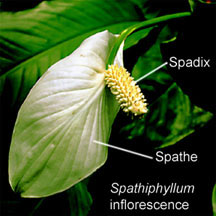 A
secretory structure found at the tip of a leaf that excretes water on
the blade surface through the process of guttation. See also guttation
A
secretory structure found at the tip of a leaf that excretes water on
the blade surface through the process of guttation. See also guttation
I
inflorescence (in-flor-ES-sense)
A
group or cluster of flowers such as the collective structure of an
aroid's spathe and spadix. An inflorescence is not a flower but is
instead a group of flowers that form along the spadix. Some produce imperfect flowers with
the sexes divided while others produce perfect flowers with both sexes in
a single flower. See also flower, spathe and spadix
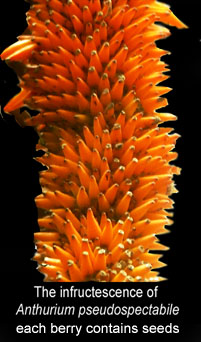 infructescence
(in-fruct-ES-sense)
or
infructescence
(in-fruct-ES-sense)
or
(in-fruit-ES-sense)
A fruit-bearing former inflorescence once it has been pollinated. The berries that form on the spadix of an aroid contain seeds that are spread by birds, insects and mammals and other animals through the forest
internode (INTER-node)
Stem segments or sections that lie between nodes. Internode measurements are used to define or determine the species in some cases. See also node and stem
interprimary leaf vein (inter-PRI-mary leaf vein)
Secondary veins of slightly lesser prominence found between the primary leaf veins but of larger size than the smaller tertiary veins. See also primary leaf veins and tertiary leaf veins
intravaginal squamulae (INTRA-va-gin-al SQUA-mules)
Small, pointed structures borne in rows around the stem at the base of and inside the petiole sheath with each petiole possessing a separate row of scales. They are not easily visible until the leaves fall off the stem so they are exposed. While they are frequently present on Philodendron subgenus Philodendron they are so tiny as be difficult to observe. Alternatively, on subgenus Meconostigma they are large and usually highly different from species to species. The literal meaning is scales inside the sheath

involute vernation (IN-vo-lute ver-NATION)
A type of in bud leaf folding, which emerges from the cataphyll. Observed when a newly developing leaf emerges from the cataphyll with both margins (edges) on opposing sides of the leaf blade rolled separately forming two inward facing tubes that meet at the midrib of the leaf. Aroids in the genus Lagenandra, Anthurium section Pachyneurium as well as species in the genus Amorphophallus exhibit involute vernation. See also Convolute vernation and Supervolute vernation.
L
lamina (LA-min-a)
The blade of a leaf. From the Latin lamina meaning a blade or a thin plate
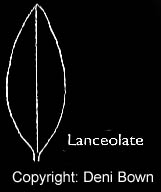
lanceolate (LANCE-ee-o-late)
Often used to describe a long thin very narrowly ovate leaf blade, broadest in the lower half and narrowly pointed. May be used to describe any long, thin part of a plant
laticifer (la-TIC-eef-er)
A cell or structure of plant cells through which latex flows. A single laticiferous cell is simple while a structere of cells is complex
laticiferous (la-te-KEEF-er-ous)
A plant cell, structure of cells or duct that contains latex.
leaflet
The leaf-like blades of a compound leaf, sometimes supported by a petiolule. See compound leaf and petiolule
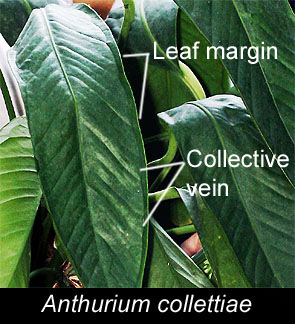
leaf
margin
The
edge of the leaf.
leaf scars
The mark left on a stem after a petiole and leaf falls. Leaf scars can be sometimes be used to identify a species
leptocaul
To possess a thin stem that is capable of quickly overgrowing other species. Leptocaul plants often dominate in temperate and subtropical climates
leucoplast (LU-ko-plast)
Leucoplasts are a category of small non-pigmented clear structures known as plastids (organelles) in plant cells which have various functions but no color. An organelle is a specialized sub-unit within a cell that has a specific function. These colorless plastids are found in the cells of roots and the underground storage organs including underground stems such as tubers, bulbs and corms. They are involved in the storage functions of these organs including the storage of foods such as starches, lipids and proteins however some have no involvement at all in the storage process but instead process fatty acids as well as amino acids. Typically leucoplasts are much smaller than chloroplasts and have no involvement in the photosynthesis in the leaves of plants including variegation although an article in The Botanical Review, Vol 55, April-June, 1989 No. 2 entitled The History of Research on White-green Variegated does define it as such. The term is rarely used in aroid literature See also Photosynthesis
ligulate (LIG-you-late)
Shaped like a small tongue or strap See also Ligule
ligule or ligular (LIG-ule, LIG-you-lar)
A small tongue-like or strap-like structure such as the corolla of a ray of the florets of the inflorescences of some genera including some aroids. A scale-like membrane that covers surface of a leaf See also Corolla, florets and inflorescence
 linear or lineate (LIN-ee-ar) and (LIN-ee-ate)
linear or lineate (LIN-ee-ar) and (LIN-ee-ate)
In a line or streak, also a long thin leaf shape
Linnaean taxonomy (lin-EH-an tax-ON-o-me)
The classification system developed by Carl Linnaeus (1707-1778), which was, described in his Systema Naturae (1735) as well as other works. Linnaeus developed Kingdoms (Animalia and Plantae) divided into classes, orders, genera (plural of genus), and species
lithophyte
(LITH-o-fite)
A plant that grows
with its roots attached to rocks.
lobe
A subdivision of a leaf See also Anterior lobe, Posterior lobe
locule (LOKE-you'll)
A cavity or chamber within the ovary of a female flower. A simple ovary has a single locule while a compound ovary has more than one. The number of locules is usually the same as the number of carpels. From the Latin loculus meaning little place. See also carpel
M
maculate
(MA-cu-late) or
(MA-cu-lat)
Spotted or mottled with irregular spots. From the Latin maculatus past participle of macula meaning to stain
marcescence (mar-ES-sense)
Leaves, which die early but do not immediately fall from the plant
membranaceous (mem-bran-EH-shus)
Possessing the consistence of a membrane. Thin and sometimes semi-transparent
meristem (MER-ee-stem) or apical meristem
The tissue in all plants capable of dividing to form new cells known as meristematic cells, Meristematic cells are located in areas of the plant where growth can take place including the axilary buds. The meristem is a group of plant cells that may divide indefinitely to provide new cells for plant growth. Some meristematic zones are the cambium layer (the layer of actively dividing cells beneath the bark of a tree or bush that form xylem tissues), shoot tips, root tips, and buds. An apical meristem is situated at the apex which is at both root and shoot tips. Lateral meristem is found in the vascular and cork cambia while intercalary meristem is found at internodes or stem regions between the points where the leaves and leaf bases attach. Shoot and shoot tip culture of excised meristems placed and grown in a suitable nutrient media is known as tissue culture where the actively growing tissue is used to artificial clone or micro-propagation of ornamental plants. See also Tissue Culture, Stems, and Clone
mesocarp (MES-o-carp) or (ME-so-carp) the latter British
Part of a layer within the fruit, which surrounds the seed, typically the part that is most edible or delicious. The result is often to allow the bird or animal to pass the undigested seed through their digestive system and thus spread it through the forest. See also pericarp
metamorphoses (met-a-MOR-ho-is)
Not normally used in relationship to plants. A change in appearance, character, condition, or function such as a change in the form and habits of an animal during normal development. Metamorphosis includes such changes as the transformation of a tadpole into a frog. In plants metamorphosis is normally referred to as ontogeny. See Ontogeny
metallophytes (see Ultramafic)
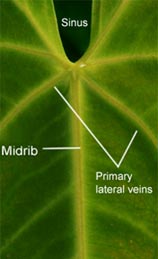
midrib
The thick central vein which separates the two halves of the leaf. It mechanically supports the leaf as well as being the means for transport of nutrients and water. See also Primary lateral veins
monocot or monocotyledons
(MO-no-cot) and (mo-no-COT-lay-dons)
One of two major flowering plant groups with the monocot group containing 50,000 to 60,000 species. Monocots are traditionally recognized by having a single seedling leaf (cotyledon). See also dicots and cotyledon
monopodial
(mo-no-PO-dee-al)
A stem growth type. Monopodial growth is when a stem continues to grow from the tip even if it also produces side branches. See also sympodial
morphogenesis
(mor-fo-GEN-e-sis)
The progressive change during the growth and formation of an organism, which includes differentiation and the change of both tissues and organs during their development
morphology (mor-FOL-o-gee)
The study of the external form and structure of an organism or one of its parts
as opposed to the study of the internal parts known as anatomy, however
sometimes used synonymously. Sometimes used to describe the
structure of an animal, plant or their individual parts such as a cell
while describing their varieties, homology, and metamorphoses, yet
distinct from their dissected anatomy. A branch of biology that deals
with the form and structure of organisms without necessarily considering
their function. See Anatomy
myrmecophyte (meer-ME-co-fite)
A plant that lives associated with a colony of ants and possesses specialized organs that provide shelter and/or food for the ants. There are often extrafloral nectarines or other tissue from which the ants may draw nourishment. The plant benefits by the protection from predators that the fierce ants provide. See extrafloral nectary
N
nectar
A juice, free flowing or viscous (sticky), with a high sugar content which often serves to attract pollinators
nectary
A gland or gland-like organ (either raised or depressed) capable of secreting a juice known as nectar with a high sugar content normally serving to attract a pollinator but which may be used to entice an insect or animal to thwart predation such as foraging against the plant as in an extrafloral nectary. See also extra-floral nectary
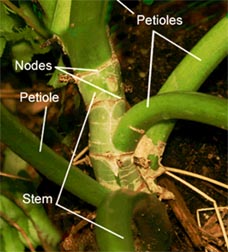
Neotropical
The Neotropic or Neotropical zone is one of eight terrestrial ecozones
found on our planet. The Neotropics includes South and Central America,
southern Mexico, the Caribbean islands, and southern Florida. Neo means
new, as in New World
node
The point on the stem where leaves, cataphylls and usually roots arise in contrast to the intervening region which are called the internodes.

O
oblanceolate
(ob-LANCE-ee-o-late)
A reversed lanceolate or lance shaped leaf, which is attached to the petiole by the pointed end with the end of the leaf lamina being oblong-rounded. See also lanceolate
 obovoid
(ob-O-void)
obovoid
(ob-O-void)
A leaf with the shape opposite to ovoid, as to have such as having the wider part of the blade towards the tip. Sometimes described as obovate
obtuse
(ob-TUSE)
A
plant part or organ having a blunt or rounded (rather than sharply
pointed) tip. Used to describe a leaf that is rounded at the apex
(end or tip) and
also a blunt angle at which one structure leaves another
ontogeny
(ont-O-gen-ee)
The life cycle or course of development of any organism from the moment the seed or egg is fertilized up through adulthood. A specialized use in Araceae describes the multiple changes in the development of a leaf blade from the juvenile through the adult form
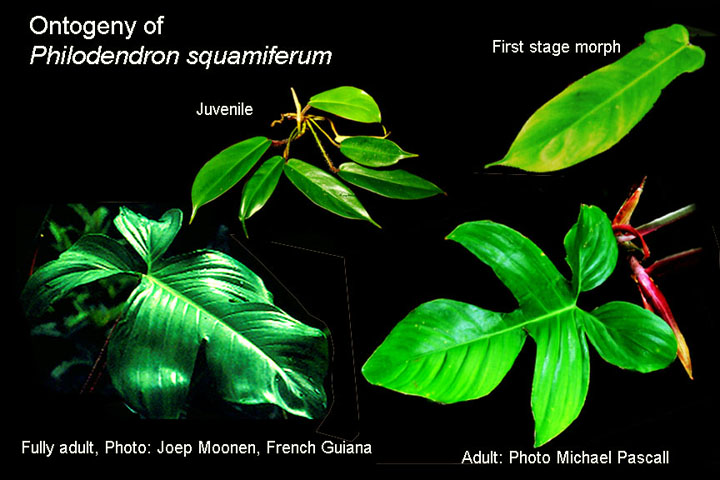
organelle
An organelle is a plastid or specialized sub-unit within a cell that has a specific function and may be responsible for photosynthesis, storage functions including the storage of foods such as starches, lipids and proteins and for their synthesis
ovary
The enlarged rounded basal portion of a carpel or a group of fused carpels (pistils) found in the flower, which contains one or more egg cells known as ovules. See also carpel, pistil, ovule
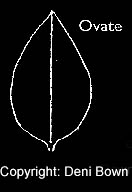
ovate
(O-vate)
In botany used to describe a plant part that is egg-shaped (broad and rounded) at the base while tapering toward the apex (end or tip)
ovoid
(O-void)
Used to describe a fruit or plant organ that is egg-shaped in three dimensions
ovule
(OV-you'll)
A minute structure that contains the embryo sac surrounding a nucleus which develops into a seed once fertilized with pollen
P
pachycaul PACKY-call
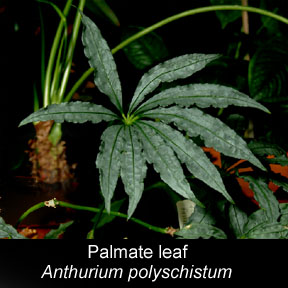 From
the Greek "Pachy" meaning thick, stout or to have thick skin. To possess
a thickened stem.
From
the Greek "Pachy" meaning thick, stout or to have thick skin. To possess
a thickened stem.
palmate (palm-ATE)
Leaflets coming from a single point where the petiole joins the blade or
deep divisions in the leaf blade, whose main veins arise at one point,
to give some resemblance to a hand. See also pinnate
papilla or papillose pa-Pil-la or pahp-IL-lose)
From the Latin meaning "nipple". A small blunt projection, normally from a cell, a type of trichome often covered with wax. Suspected to protect from sunlight and the loss of moisture. Papillose is to possess a small blunt projection.
papyraceous (pa-pee-RAY-shus) or (pa-per-EH-shus)
Texture resembling paper or parchment
parallel venation
The arrangement of leaf veins when they are parallel. The venation is parallel if it does not branch regardless of where it is directed. In Philodendron the minor veins are parallel and the venation does not go just to the apex (end or tip. See venation
PCR Cycle (Photosynthetic Carbon Reduction) See Autotroph

pedate, pedately lobed, padatisect (PAHD-ate, PAHD-ately, pah-DAT-ee-sect)
To be palmately divided or have palmately divided lobes. A leaf having deeply divided radiating lobes. Pedatisect is to have the leaf venation pedate See also Palmate, pedate and venation
pedicel (PAHD-ee-cel)
The support of a single flower. May be applied to any flower
peduncle
(PED-uncle)
 The stalk the supports the inflorescence of an aroid
The stalk the supports the inflorescence of an aroid
peltate
(PEL-tate)
A
leaf, often more or less circular, with the petiole attached to the
undersurface rather than the base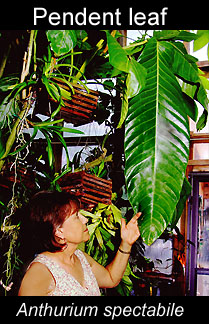
pendent leaf
A leaf that hangs downward
perianth (PERI-anth)
The outer whorls (layers) of a flower. Sometimes called the perigone in
some aroid genera and species.
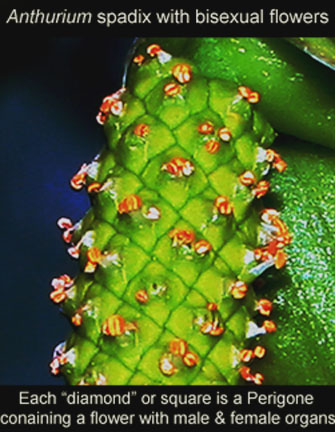
pericarp (PERI-carp)
The outer layer of the fruit wall. See also mesocarp
perfect flower (see bisexual flower)
perigone
(per-IH-go-nee)
The
outer parts of a flower enclosing the essential organs of a flower. In a
flower with more showy petals and sepals than those of the aroids this
is usually called the perianth. The perigone of an Anthurium is
the roughly "diamond shaped" portion of the spadix that encloses the
very small individual flowers
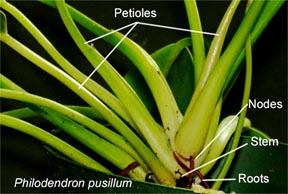 petiole
(PET-ee-ole)
petiole
(PET-ee-ole)
A part of a leaf, the stalk that attaches a leaf blade to the stem. The structure of the petiole is important to the identification of a species since it may be terete (round), square, quadrangular or have other shapes as well as possess lines known as striations, single or multiple canals known as a sulcus (then said to be sulcate) as well as other unique features. Plant collectors often incorrectly call a petiole a “stem”. See also stem, sulcus and sulcate
 petiolule
(PET-ee-ole-lule)
petiolule
(PET-ee-ole-lule)
The stalk of a leaflet in a compound leaf. Part of the leaflet. See petiole and compound leaf
petiole sheath (PET-ee-ole sheath)
Winged extensions at the sides of the petiole that may envelop a newly developing leaf blade
petiolar insertion
(pet-ee-OL-insertion)
The point where the petiole and leaf blade join
pheromone
(FAIR-o-mone), sometimes also (FAIR-mone)
An often-fragrant perfume-like scent produced by various parts of the plant during anthesis to attract potential pollinators. See also thermogenesis
photosynthesis (pho-to-SYN-the-sis)
In green plants and some other organisms including algae and specialized bacteria, photosynthesis is a chemical reaction caused by the interaction of chlorophyll within the plant and the sun's light combined with carbon dioxide, inorganic salts and water to produce carbohydrates. In green plants the autotrophic process converts physical energy from sun light into carbohydrates in the form of sugars. The process is also known as CO2 Fixation or the PCR Cycle (Photosynthetic Carbon Reduction). The biological term reduction indicates the hydrogen is molecularly stripped away from the oxygen. These sugars are produced for the purpose of providing energy and food to the plant, thus growth. Most forms of photosynthesis also release oxygen to the atmosphere as a byproduct. Photosynthesis actually occurs within cellular chloroplasts and for each individual plant species there is a minimum and a maximum temperature below or above which photosynthesis does not occur. Tropical plant species are far more limited in their range of temperature related photosynthesis than are temperate plant species that thrive in colder climates. See also Autotroph and Chloroplast
phylloclade (see cladode)
phylogeny (phy-LOG-any)
The ancestral history of a species as deduced by their development. The evolutionary relationship or history of taxonomic levels, particularly their lines of descent. A tribe.
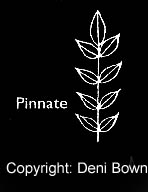
pinnate or pinnatifid
(PIN-eh) (PIN-ate) (pin-AT-if-id)
A leaf with leaflets arranged more or less like a feather is said to be pinnate. A single leaf with divisions reaching almost to the midrib is pinnatifid. See also palmate
pistil
(PIS-til)
The female, ovule-bearing organ of a flower, made up of the stigma, style, and ovary
plastid (PLAS-tid)
Plastids are organelles in plant cells which have various functions.. See also organelle
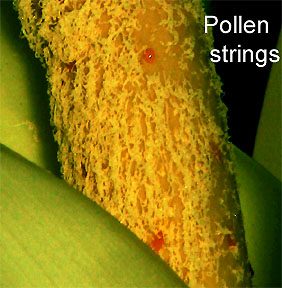
pollen
A fine to coarse powder (pollen grains) that produce the male gametes (sperm cells) of seed plants Sometimes appears as strings
pollination
The process through which pollen is transferred at male anthesis to a plant of the same or similar species currently at female anthesis, thus enabling fertilization and sexual reproduction. See also Fertilization
polyphyllous
Many leaved.
polyploid
(POLY-ploid)
A polyploid is an organism that has extra sets of chromosomes. Polyploidy can cause oddities including a difference in size
posterior lobe
Paired portions of the leaf blade below the point where the petiole
joins the leaf known as the petiole insertion. In genera such as
Anthurium it may appear the posterior lobes are above the point of the
petiole insertion due to the bend at the geniculum. Also known as
Anterior
lobes.
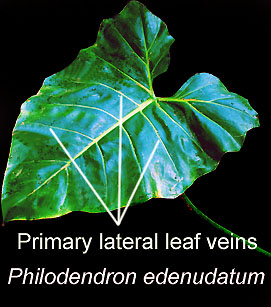
primary lateral leaf vein
The veins branching off the midrib and extending to the margins
prominulous (pro-MIN-u-lus)
Weakly raised, standing out just a bit, as in a slightly raised leaf vein.
prophyll
(PRO-fill)
A leaf formed at the base of a shoot, often smaller or of a different form to those produced later. A double ribbed cataphyll
protogynous [proh-tuh-JAHY-ous)
A flower in which the receptive female stigma is spent before the pollen is shed from the anthers of the same flower. Typical of bisexual flowers in the family Araceae (aroids) /see Bisexual flowers
proximal
Indicating the part of a plant organ that is closest to its point of attachment. (As opposed to distal) See also Distal
pubescence
(p'you-BES-sense)
Hair-like growth sometimes found on the petioles, leaves, stems and
other parts of Araceae. There are specialized terms to describe the
length of hair, its stiffness and the density of the covering such as
indumentum but indumentum is broader and includes scales.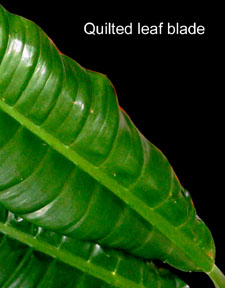
Q
quilted blade
A leaf blade with the tissue between the main veins broadly arched in a form similar to a quilt.
R
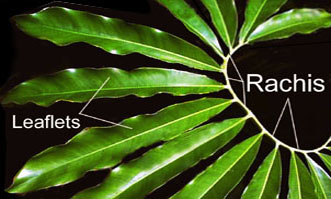 rachis or rhachis
(RA-kis)
rachis or rhachis
(RA-kis)
The axis or stalk within a compound leaf above the petiole that supports the leaflets. The individual leaflets are often supported by petiolules, The total of all the leaflets then compose a single compound leaf. A rachis is commonly supported by a single petiole. The term is also often used to describe a compound inflorescence, especially with some orchid species. Sometimes used interchangeably with peduncle by some aroid writers when describing Araceae with multiple inflorescences. See compound leaf, peduncle and petiole
raphide, raphid, or rhaphid (RAF-ide)
The needle-shape crystals of calcium carbonate or calcium oxalate found in specialized plant cells called idioblasts, which can often be felt as a tiny bump on the surface of a leaf or stem.. Raphides are believed to be a defensive mechanism against plant predators since they are likely to cause great discomfort if ingested as well as tear the soft tissues of the throat and/or esophagus of a plant predator. Raphides are the primary reason aroid species are often claimed to be "poisonous" on internet websites. See also calcium oxalate crystals
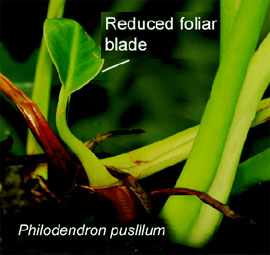
reduced foliar blade
A leaf blade that does not grow to the potential size seen elsewhere on the plant. A reduced leaf blade may be produced as a result of the plant temporarily changing its shoot growth from monopodial to sympodial growth but is common in sympodial species.
reflex
To curve backwards. Sometimes used to describe the backwards-curving cataphyll or spathe of certain genera
repent
A manner of stem growth running roughly horizontally across the ground's surface.
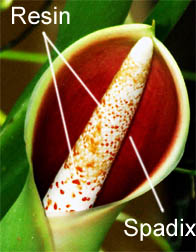
resin
A sticky exudate (fluid) of the leaf, roots and other plant parts including the spathe and spadix of some aroid species' inflorescence. In Philodendron root resin canals generally occur in the outer layer known as the cortex. On the inflorescence the spathe may produce resin through adaxial canals during anthesis
restinga
(res-TING-a)
In Brazil the restinga is a distinct moist coastal tropical and subtropical rain forest formed on sandy acidic soil that is nutrient poor. Restinga are characterized by medium sized trees and shrubs, which adapt to the often dry and nutrient poor conditions, which are often populated with aroid species.
reticulate veins
The reticulate veins are the smallest visible vein form within small areas called areoles, a condition known as areolate. See also Tertiary veins
revolute (rev-o-LUTE)
Curved or curled back. Commonly used to describe a leaf blade, the term i
ndicates a leaf or petal is rolled backward toward the abaxial surface from the axis or margin. When fully revolute the margins often overlap. From the Latin revolutus
rheophyte
(REE-o-fite)
Rheophytes include semi-aquatic as well as aquatic plant species which live attached to stone in fast moving currents. The force of the fast moving current creates oxygen-rich water. Rheophytes are able to live in this environment due to their streamlined leaves that produce little resistance to the flow. They possess extremely strong wide spreading root systems which steadfastly hold the plant in position. Rheophytic plants include some Anthurium species
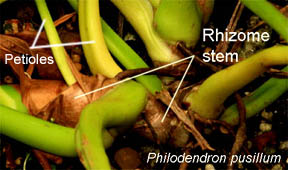 rhizome
(see stem)
(RYE-some)
rhizome
(see stem)
(RYE-some)
or (RYE-zome)
A stem that runs either along or just beneath the surface of the soil
riparian
(rye-PAIR-ee-an)
A small group of plants that grow semi-aquatically in the region separating land and a stream. Araceae that grow as riparians including Spathiphyllum, Hottarum, Bucephalandra, Aridarum, Homalomena, as well as a group of Anthurium species, and others. Nearly all riparian species are found in the Asia tropics
root
The plant organ (lacking buds, nodes or leaves), which absorbs water and
mineral salts as well as anchors the specimen to a host or the soil and
sometimes stores food. Although in terrestrial species the roots are
normally underground, in Araceae they are frequently found hanging free
in the atmosphere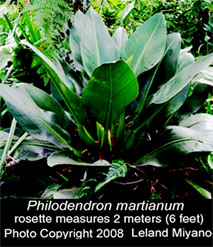
rosette
A circular or rose-shaped arrangement of leaves normally spread horizontally arising from a short as well as sometimes modified stem
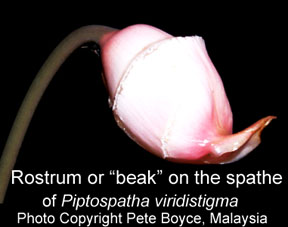
rostrate or rostrum (ROST-rate or ROST-rum)
To possess a beak similar to the beak of a bird. In the aroid genus Piptospatha the spathe limbs terminate with a distinct beak See also Spathe limb
rosulate
(ROSE-you-late) or (ROSE-you-lat)
Arranged in a rosette-like cluster. Used to describe a rosette-like cluster of leaves as well as bracts
rupicolous
(roo-PICK-o-lus)
Plants that grow among and sometimes over rocks
rugose
(ROO-gose)
Possessing a rough, wrinkled surface or appearance. Sometimes used to describe the venation of species with a prominent tightly woven vein structure visible on a leaf surface.
S

sagittate
(SA-jit-ate)
The shape of an arrowhead, having the posterior lobes of a leaf longer than broad and directed toward the base. In some European countries the term may be used differently
saprophyte (SAP-rue-fite)
Plants and organisms including fungi, molds and bacteria that live on dead organic matter (plant or animal tissue) for a source of nutrition and metabolic energy as well as recycle the material into the soil. The majority of saprophytes do not produce chlorophyll and do not produce nutrients through photosynthesis. Also used to describe leafless plants including orchids that derive nourishment from decaying or dead fungi in the soil. Important to home plant growers as a result of the ability of saprophytes to destroy roots and other plant material due to excessively soggy soil that is devoid of oxygen.
saxicolous
(sak-SIC-o-lus)
Growing around or on rocks, stones and walls such as a rocky cliff
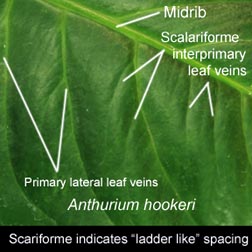
scalariforme
(scay-LAR-i-form)
Veins or other plant parts that grow in an evenly spaced formation resembling the rungs of a ladder
scandent
(SCAN-dent)
Used to describe plants that climb, but usually restricted to stems that flop over a support, and continue upwards from there
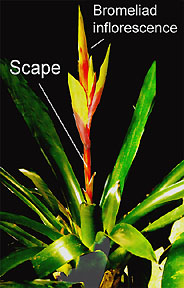
scape
Scapes are flower supporting stalks that are almost always leafless (depending on the genus and species), A scape rises from the crown or roots of a plant and may support a single flower or an inflorescence of many flowers. In Bromelia (bromeliads), the scape is the support of an inflorescence. See also Inflorescence
scototropic or skototropic
(sko-to-TRO-pic)
From the Greek skotos meaning darkness. Describes the tendency of vining plants to grow towards the darkness found in the shade of a tree or object such as a cliff which will eventually allow the specimen to climb towards brighter light. This is a term which many people feel unnecessary, preferring negative phototropism, which means growing away from the light
self-heading
Often used to describe an aroid with a thick trunk that can stand erect for a time, often then either leaning on a tree or snaking over the ground and turning up at the tip. See arborescent
sessile
(SESS-ile)
Without a stalk. Used to describe a leaf or inflorescence that grows
attached directly to the stem without a petiole or peduncle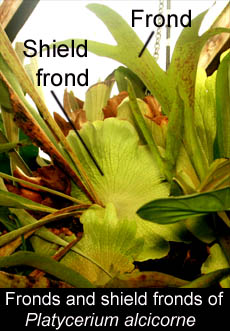
shield frond
A sterile (non-reproductive) clasping frond used to hold water as well as attach a fern or other plant species to a host. See also frond
sigmoid (SEEG-moyd)
Growth curved in two directions similar to the letter "S"
sinuate (SIN-you-ate) or (SIGN-you-ate)
From the Latin sinus, to bend, curve or wind in and out such as a leaf
blade possessing wavy leaf margins or lobes.
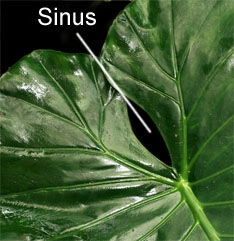
sinus (SINE-us)
The area between the lobes of a leaf
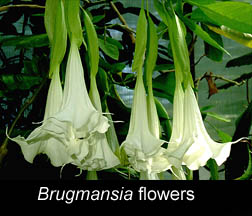 soporific
(sap-a-RIFIC)
soporific
(sap-a-RIFIC)
A drug or plant part that tends to induce drowsiness, a state of hallucination or sleep. The flowers of species such as Brugmansia trees, which are found naturally from the Pacific slope of Colombia, through Peru and portions of Chile, contain a hallucination known as Scopolamine that is used as a component in medical therapy as well as a chemical agent known to cause powerful hallucinations
sori plural of sorus
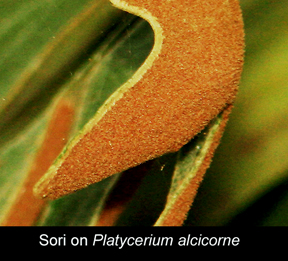 A
group or cluster of plant reproductive bodies known individually as
sorus. Clusters of spore cases known as sporangia. In ferns, a cluster
of sporangia on the underside of a fertile frond. Sometimes used to
describe a mass of spores bursting through the epidermis of the host
plant of a parasitic fungus See also Sorus, Sporangia and Spores
A
group or cluster of plant reproductive bodies known individually as
sorus. Clusters of spore cases known as sporangia. In ferns, a cluster
of sporangia on the underside of a fertile frond. Sometimes used to
describe a mass of spores bursting through the epidermis of the host
plant of a parasitic fungus See also Sorus, Sporangia and Spores
sorus
A fruiting structure made-up of a mass of spores or sporangia. A cluster of sporangia borne on the underside of a fern frond. Also a reproductive structure in certain fungi and lichens See also sori
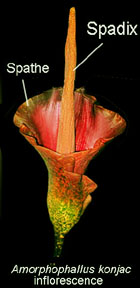
spadix (SPAY-dicks)
A typical part of the inflorescences of Araceae (aroids) surrounded by a spathe. The spadix is the fleshy axis at the center of the inflorescence which bears flowers
spathe
(SPAY'th)
Typical of Araceae (aroids), a modified leaf or bract (sometimes large) enclosing a spadix, which may be highly colored. A spathe may take on many forms and is not a flower but an auxiliary part of an inflorescence
spathe limb
or
spathe blade
The
margin or edge of a spathe
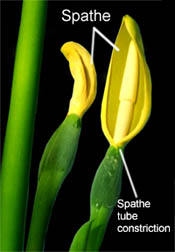
spathe tube
A spathe, which may open and close to form a tube-like enclosure or constriction around the spadix. See also spathe
s
pathulate (spath-YOU-late)To possess the shape of a spathe.
species
A group of individual organisms, which have a common characteristic, distinction or quality separating them, form other groups. All of the species with a certain number of characters in common are grouped as a genus. See also Linnaean taxonomy
sporangia plural of sporangium (spo-RAN-gee-a or spo-RAN-gee-um)
A single-celled, sometimes multi-celled structure in which spores are produced. May be a plant, fungal, or algal structure that produces and contains spores. Sporangia occur in ferns, fern allies, angiosperms, gymnosperms, bryophytes, algae, some mosses and fungi. Their spores are sometimes called sporangiospores . Sometimes known as a spore case. The sporangium is the organ that contains or produces spores See also Spores
spores
Normally a small single-celled reproductive body that is highly resistant as well as capable of survival under unfavorable conditions including heat. When growth conditions return to more favorable conditions the cell then reproduces to become a new individual. Depending on species, the cell is capable of growing into new a organism including the production of certain ferns, bacteria, fungi, molds, algae, and non-flowering plants See also Sori
stamen (STAY-men) or (STA-men)
The male reproductive organ of a flower consisting of a filament and an anther. The anther consists of two thecae (a sheath-like structure) in which the pollen is produced
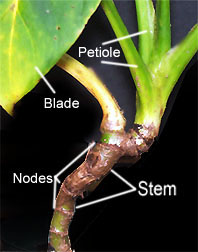 stem
stem
The base, central axis and main support of a plant normally divided into nodes and internodes. The nodes often produce a leaf in the axil of which they produce roots and hold buds which may grow into shoots of various forms. The stem's roots anchor the plant either to the ground, a tree or to a rock. A stem may even spread as a repent rhizome creeping across the soil. May either grow above ground, underground or partially above the soil. Specialized stem forms are called a corm, tuber or bulb. See also petiole
sterile zone
A region of male flowers incapable of sexual reproduction, which sometimes divides the female, and male flowers on a bisexual inflorescence. See also inflorescence
stigma
(STIG-ma)
The pollen-receptive surface, usually sticky, where the pollen enters the pistil. Usually the stigma will bear a sweet solution, which can attract insects to the sticky surface of the stigma where pollen is received and on which pollen germinates
stigmatic hairs
(stig-MAT-ic
hairs)
Small hairs sometimes known as trichomes at the end of the stigmas, designed to entrap the pollen grains. These trichomes may also induce germination of the pollen grains. (see stigma and trichome)
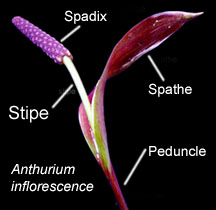
stipe
(as
spelled or STEEP-eh)
A stalk that supports some other structure. Used to describe a length of stalk located between the spathe and the spadix in the inflorescences of some aroids
stipulate (STEEP-you-late or STIP-you late)
To possess stipules See stipule
stipule (STEEP-ule or STIP-ule)
Variable in size and appearance, stipules are leaf-like or scale-like appendages at the base of the petiole, normally found in pairs. Stipules may also be on the nodes of the stem. When observed there are generally two, one on each side of the leaf that sometimes appear to protect the young leaf before it develops
stolon
(STO-lon)
A stem runner or shoot that runs atop or just under the ground from a plant with the ability to produce new plants from buds along its length or at the apex (end or tip)
stoma, plural stomata
(STO-ma)
pl. (sto-MA-ta)
A pore in the epidermis of a leaf or stem used for gas exchange with the atmosphere. Vital in controlling water emission during transpiration. See also transpiration
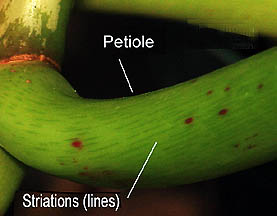
striate or striation
(STREE-ate)
and (stree-EH-shun) or (S'TRY-eh-shun)
Fine lines (often parallel) on the surface of the rib or vein of a plant, petiole, spathe or other part of a plant
subcoriaceous (SUB-co-ree-eh-shus)
Used to describe a leaf blade that is less than leather-like to the touch. See also coriaceous, membranous, papyraceous
subgenus
A
taxonomic rank directly below genus where all species in the subgenus
possess some common characteristics
subobtuse
(sub-ob-TOOSE)
Not
completely obtuse. See obtuse
subtribe (see tribe)
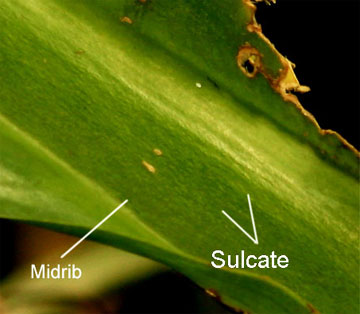
sulcate
(SUL-sate)
or (SUL-kate)
Possessing grooves. Used to describe the sulcus commonly observed on the midrib, petiole and other parts of Araceae, which are important to the determination of a species
sulcus
(SUL-cuss)
A furrow or groove such as the depression sometimes observed on the upper surface of a petiole commonly known as a C shaped depression (for a photo see Canaliculate)

supervolute vernation
A newly emerging leaf blade with one leaf margin rolled inward while the opposite margin is rolled around the first. Similar to the coiled whorl or spiral of a conch shell. Supervolute is synonymous with convolute vernation but there is a slight difference since convolute involves a succession of leaves being formed while in supervolute vernation there is no new leaf to be formed in succession as can be seen in the drawing to the right.. See also convolute vernation and Involute vernation
sympodium or sympodial (sim-PO-dee-um) or (sim-PO-dee-al)
A stem in which growth occurs by successive side branches replacing one
another as the main shoot with no single shoot continuing indefinitely.
In many aroids juvenile growth is monopodial but later becomes
sympodial. The
stem may consist of multiple branching segments growing in roughly a zigzag
pattern.
See also monopodial
synflorescence
(SIN-flor-essence)
A branching unit where the inflorescences arise one after another normally in sequence with no return to foliage. Observed in some but not all genera of aroids
synonym
In botany a name of a species in the same genus for which an earlier name, now accepted as correct, has been published. A synonym is no longer considered an accepted species name
T
taxon
A
general word for any of the divisions of the hierarchy of names used for
groups of organisms
taxonomy
The art and science of classifying living organisms into taxa (plural of taxon)
tepals
(TEE-pals) or (TAY-pals) both correct
Part of the perianth, which is the outer part of a flower. Commonly used when the segments of the perianth are of similar shape and/or color and there is no distinction in the calyx (sepals) and corolla (petals). See also perianth

terete
(TEAR-eat)
Round or cylindrical when viewed in cross-section. Used to describe the shape of a petiole or other plant part
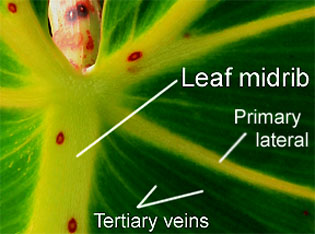 tertiary veins
tertiary veins
The repeatedly branched veins arising from and connected to the primary lateral veins and interprimary veins. The reticulate veins are the smallest visible vein form within small areas called areoles (also a condition known as areolate)
thecae (THE-ka)
A case, sheath or covering such as the pollen sac of an anther that covers a portion of the plant's stamen. The case covering the sporangium of a fern. See Sporangium and Anther
thermogenesis
The production of heat in the spadix of an inflorescence (thermo= heat,
genesis= birth) generated by a rapid oxidation of starch stored in the
spadix. It is triggered by salicylic acid. Thermogenesis causes the
release of an odor attractive to a pollinator known as a pheromone which
is distributed by an increase in temperature. See also pheromone
For a complete explanation see this link:
Natural and artificial pollination in aroids
tissue culture
The asexual propagation of fragments of a suitable parent plant in order to produce clones of it in large quantity. In the process cells are grown in nutrient solutions in a laboratory until they form a mass of tissue. These then get different chemicals to induce roots and leaves. Once developed these tiny plants are transplanted into a potting medium. Those from a commercial lab are normally distributed to the commercial plant growing industry
transpire or transpiration
The loss of water to the atmosphere through the pores of a leaf primarily through the stomates (stoma). See also stoma
tribe
In plant taxonomy a rank between family or subfamily and genus. A tribe comprises genera that have shared features that serve to distinguish those genera from others in the same genera. Further tribal divisions are known as subtribes. See Taxonomy and Genera
trichome (TRICH-ome)
A normally microscopic growth of hair such as a bristle or root hair
from an epidermal cell. Trichomes are varied in both shape and function
sometimes revealing important taxonomic characters. A trichome can be
elongate, scale-like or peltate, glandular or non-glandular as well as
unicellular or multi-cellular. In certain bacteria a trichome may be a
chain of vegetative cells surrounded by a slimy sheath See also
Epidermal
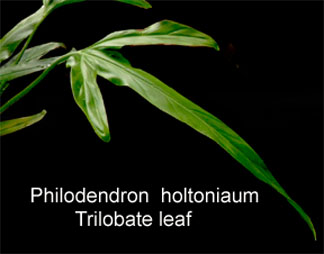
trilobate (TRI-lobe-ate)
To possess three lobes
trisect (TRI-sect)
Divided into three normally equal parts
truncate
(TRUNK-ate)
Cut off. Indicates a plant part has a blunt end, which appears to have been cut off, squared, or straight
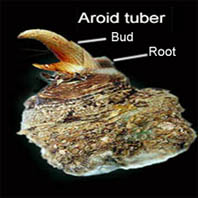
tuber
A tuber is a strongly condensed stem as well as an underground structure which is almost entirely a starch storage organ without a basal plate. The buds for future growth and the roots all develop at the apex or top of the tuber. The tuber can sometimes form as the tip of a stolon or runner. Stolons are stem runners or stem shoots that run atop or just beneath the surface of the soil's surface to produce new plants. Should not be confused with a bulb or corm. See stem, stolon, corm and bulb
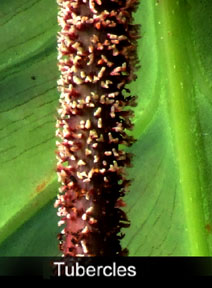
tubercle
A small raised nodule on a plant's surface, a small rounded wart-like protuberance
tuberous roots
Tuberous roots are true root tissue that do not possess buds. They are swollen and possess tuberous portions that radiate from a central point known as a crown. They do not have buds but appear and act somewhat like tubers without being a true tuber or stem. Each root has a portion of stem tissue attached but they are nutrient-storing root tissue with thickened fleshy parts. They typically grow in a cluster and may also put out fibrous roots to take up moisture and nutrients . Tuberous root systems often permit the plant to survive difficult annual growing seasons that may kill the portion of the plant above the soil.
U
ultrabasic (ool-TRA-basic, see ultramafic)
ultramafic (ootra-MAFF-ic)
The type of rocks found in the Earth's mantle. Used in geology to
describe igneous rocks and soils (those of volcanic origin) that contain
magnesium and iron with small amounts of silica
and frequently have elevated
chromium and nickel, both toxic to most plants but in which
ultramafic-adapted plants can tolerate.
A number of Asian aroids are obligated to grow in ultramafic soil (the
same as ultrabasic rocks and soil) and its associated ecology. Extreme
forms of these plants are termed metallophytes and they are often highly
associated with ultrabasic soils and even go so far as to accumulate
metals in their tissues, notably in their sap. No known aroids are
classified as metallophytes. Ultramafic may also refer to soils or
bedrocks that possess such high metal content some plants may not be
able to survive.
undulate leaf margin
The edge of a leaf with a wavelike appearance
unisexual inflorescence
A
type of flower arrangement where unisexual flowers are arranged on the
same axis but in Araceae not usually borne together as species which
produce an inflorescence with imperfect male as well as imperfect female
flowers found in separate zones (not intermixed). Some of the Araceae
genera that produce a unisexual inflorescence include Philodendron,
Alocasia, Caladium, Amorphophallus and Xanthosoma. See also bisexual
V
variegation (VAR-ee-ah-GAY-shun)
A phenomenon
observed in some plants where partially or irregularly colored patches
or streaks of different colored tissues in plant organs are observed,
normally on a leaf or stem but sometimes on a flower. Variegation
may the result of natural DNA characteristics, the suppression of normal
pigment development, pathogenic infection (particularly a viral
infection known as Colour Break Virus) but may also be a mineral
deficiency
.jpg) or genetic differences within the plant's cellular structure
as a result of mutation. The virus
is a somatic mutation
induced in tissue culture. Similar mutations are being generated
in tissue culture around the globe with Spathiphyllum, Homalomena, and
Philodendron that usually involve the introduction of a benign
colour-breaking virus. Variegation is sometimes seen in nature in species such as
Epipremnum aureum (commonly called Pothos) and some Dieffenbachia as
well as other species. It is now common for tissue culture laboratories
to deliberately expose plants to the Colour Break Virus in order to chemically
induce variegated specimens that may be sold at a higher retail price.
Chimeral variegation as well as viral variegation (Color Break Virus)
are unstable and temporary since they are not passed along through seeds and often vanish in a generation or two.
Plants that are excessively variegated and lack sufficient chlorophyll
(green tissue) are often incapable of survival due to the lack of an
ability to conduct photosynthesis.
It is important you also read the
definitions of Chimera, Chloroplasts, Photosynthesis and Autotrophs
or genetic differences within the plant's cellular structure
as a result of mutation. The virus
is a somatic mutation
induced in tissue culture. Similar mutations are being generated
in tissue culture around the globe with Spathiphyllum, Homalomena, and
Philodendron that usually involve the introduction of a benign
colour-breaking virus. Variegation is sometimes seen in nature in species such as
Epipremnum aureum (commonly called Pothos) and some Dieffenbachia as
well as other species. It is now common for tissue culture laboratories
to deliberately expose plants to the Colour Break Virus in order to chemically
induce variegated specimens that may be sold at a higher retail price.
Chimeral variegation as well as viral variegation (Color Break Virus)
are unstable and temporary since they are not passed along through seeds and often vanish in a generation or two.
Plants that are excessively variegated and lack sufficient chlorophyll
(green tissue) are often incapable of survival due to the lack of an
ability to conduct photosynthesis.
It is important you also read the
definitions of Chimera, Chloroplasts, Photosynthesis and Autotrophs
variation or variability
Differences found in a single taxa that do not appear to be identical to other specimens of the same species. An almost universal phenomenon where the leaves and other plant organs of a single species may take on a variety of shapes. The shape of a plant's leaves do not necessarily determine the species
vegetative
To grow or cause to grow. Used to descibe a stage or structure associated with feeding or growth rather than with sexual reproduction
vegetative reproduction
A form of asexual reproduction where specialized multicellular organs are formed by the parent, become detached, and generate new individual plants. Vegetative reproduction is the same as asexual reproduction. See asexual
veins
A
bundle of vascular organs sometimes known as ribs in a leaf or other
plant part that form a branching framework for the purpose of supporting
the leaf as well as conducting the transfer of fluids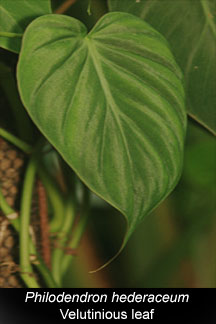
velutinous
(vel-OOT-in-us)
Velvety with fine silky pubescence (hairs). See also pubescence
venation
(ven-EH-shun)
Used to describe the arrangement or the veins of a leaf
vernation
(vern-EH-shun)
Used to describe the way a new leaf blade is rolled or folded as it
emerges from the cataphyll, sometimes known as ptyxis. See also
convolute vernation, involute vernation and supervolute vernation
verrucose (VER-ook-ose)
A warty appearance
vinaceous
(vin-EH-shus)
Purple/reddish color, similar to that of wine
X
xylem
(ZIE-lem)
A network of hollow cells in a plant's vascular system that transports water and soluble nutrients collected by the roots.
ACKNOWLEDGMENTS
The assistance of Dr. Thomas B. Croat, D. Christopher Rogers,
Elizabeth Campbell and Peter C. Boyce are gratefully acknowledged.
REFERENCES
Allaby, M. 2006.
A Dictionary of Plant Sciences.
Oxford University Press, Oxford.
Bell, Adrian D.,
Plant Form,
Timber Press, Portland-London
Bailey, Jill, Dictionary of Plant Sciences, Penguin Books
Bailey, Jill,
The facts on File
Dictionary of Botany,
Facts on File, Inc.
Bown, D. 2000.
Aroids, Plants of the Arum Family. Second edition. Timber
Press. Portland, Oregon.
Croat, T. B. 1991.
A revision of Anthurium section Pachyneurium
(Araceae). Ann. Missouri Bot. Gard. 78(3):539–855.
1997.
Croat, T.B.,
A revision of Philodendron subgenus Philodendron (Araceae) for Mexico
and Central America.
Ann. Missouri Bot. Gard. 84(3):311–704
Barbé,
Denis; Lacrois, Christian; Jeune, Bernard,
Study of Homeosis in the Flower of
Philodendron
(Araceae): a Qualitative and
Quantitative Approach
Jackson, Benjamin
Daydon, A
glossary of Botanic terms, with their derivation and accent,
Duckworth and Company, Philadelphia
Keating, Richard C.,
Anatomy of Monocotyledons, IX.
Aroraceae and Araceae,
Oxford Science Publications
Mayo. S.J., J. Bogner & P. C. Boyce. 1997.
The Genera of Araceae. Royal
Botanic Gardens, Kew
McDonald, Maurice S.
Photobiology of Higher Plants,
John Wiley & Sons Ltd., 2003
The International Aroid Society. http://www.aroid.org/
I